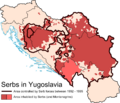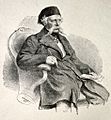Serbs facts for kids
| Total population | |
|---|---|
| ~12-13 million | |
| Regions with significant populations | |
| Former Yugoslavia | 8,200,000+ |
| ~6,200,000 (2012) | |
| ~1,300,000 (2012) | |
| 265,895 (Native Serbian speakers)(2011) | |
| ~200,000 (2011) | |
| ~40,000 (2002) | |
| ~40,000 (2002) | |
| Europe | 2,000,000+ |
| ~800,000 (2012) | |
| ~400,000 (2012) | |
| ~200,000 | |
| ~120,000 (2012) | |
| ~55,000 (2004) | |
| ~120,000 (2008) | |
| ~70,000 (2005) | |
| ~20,000 (2002) | |
| ~40,000 (2008) | |
| ~12,000 (2006) | |
| ~60,000 (2008) | |
| ~15,000 (2001) | |
| ~7,000 | |
| ~5,000 (2008) | |
| North America | 1,200,000+ |
| ~1,000,000 | |
| 80,320 (2011) | |
| Other | unknown |
| ~130,000 | |
| ~15,000 | |
| ~4,000 | |
| ~4,000 (2002) | |
| Languages | |
| Serbian | |
| Religion | |
| Predominantly Serbian Orthodox Christian | |
| Related ethnic groups | |
| Other Slavic peoples, especially South Slavs | |
The Serbs (in Serbian: Срби, Srbi) are a group of people who live mostly in the Balkans and Central Europe. They are part of the larger group called South Slavs. Most Serbs live in countries like Serbia, Montenegro, Bosnia-Herzegovina, and Croatia.
Contents
Who Are the Serbs?
Serbs are an ethnic group with a rich history and culture. They speak the Serbian language, which is unique because it uses two alphabets: Cyrillic and Latin. This means Serbs can read and write in both!
Most Serbs follow the Serbian Orthodox Christian faith. This religion is a big part of their identity and traditions. They share many cultural similarities with other Slavic peoples, especially those from the south.
Where Do Serbs Live?
There are about 12 to 13 million Serbs around the world. Most of them live in countries that were once part of Former Yugoslavia.
- Serbia: About 6.2 million Serbs live here, including those in Kosovo.
- Bosnia and Herzegovina: Around 1.3 million Serbs call this country home.
- Montenegro: More than 265,000 people identify as Serbs or native Serbian speakers.
- Croatia: About 200,000 Serbs live in Croatia, especially in the Krajina region.
- Other former Yugoslav countries: Smaller groups of Serbs live in Slovenia and North Macedonia.
Many Serbs also live outside the Balkans.
- Europe: Over 2 million Serbs live in other European countries. Large communities are found in Germany, Austria, Switzerland, France, and Sweden.
- North America: More than 1.2 million Serbs live here, mostly in the United States and Canada.
- Other parts of the world: You can also find Serb communities in Australia, New Zealand, and even the United Arab Emirates.
Serbian Culture and Traditions
Serbian culture is full of interesting traditions.
- Language: As mentioned, the Serbian language is special because it uses both Cyrillic and Latin alphabets. A famous person who helped reform the modern Serbian language was Vuk Karadžić.
- Music: The gusle is a traditional Serbian instrument. It's a stringed instrument often used to accompany epic poems and stories.
- Epic Poetry: Serbian epic poetry tells tales of heroes and historical events. One famous story is about the "Kosovo Maiden."
- Slava: A unique tradition is Slava. This is a family feast held once a year to honor the family's patron saint. It's a very important gathering for families.
- National Symbols: The wolf is a very important animal in Serbian mythology and is considered the national animal. Many Serb names and surnames come from the word "wolf." The Serbian national colors (red, blue, and white) and the Three-finger salute are also important symbols.
- Food: Traditional Serbian Christmas meals often include roasted pork, Russian salad, and red wine.
Famous Serbs
Many Serbs have made a big impact on the world.
- Saint Sava: He was a very important figure in Serbian history and the founder of the Serbian Orthodox Church.
- Stefan Dušan: Known as Dušan the Mighty, he was a powerful medieval Serbian emperor who greatly expanded the Serbian Empire.
- Karađorđe Petrović: He led the First Serbian Uprising against Ottoman rule and is considered the founder of modern Serbia.
- Nikola Tesla: A brilliant inventor and electrical engineer who made incredible discoveries in electricity and magnetism. He is famous for his work on alternating current (AC) electricity.
- Nadežda Petrović: A talented painter and one of the most important Serbian artists of her time.
These individuals, along with many others, have shaped Serbian identity and contributed to global culture and science.
Images for kids
-
Nemanjić dynasty members, the most important dynasty of Serbia in the Middle Ages
-
Serbs in the former Yugoslavia, during the Yugoslav wars
-
Vuk Karadžić, reformer of modern Serbian, which is the only European language whose speakers are fully digraphic, using both Cyrillic and Latin alphabets.
-
The national instrument gusle placed on Pirot carpet
-
Many Serb names/surnames are derived from the word wolf, which is the national animal and an important part of the national mythology.
-
Slava, a family feast in honor of its patron saint.
-
A typical Serbian Christmas meal that includes roasted pork, Russian salad and red wine.
See also
 In Spanish: Serbios para niños
In Spanish: Serbios para niños













